There’s a photograph of a woman looking out of her window at a quiet Foley Street below. All around her are boarded up windows. The buildings up and down the street are in the process of being torn down and, with them, a community is being pulled apart. Inside the old tenements the conditions are a long way from liveable. No water, gas or electricity is the everyday reality and the rats are a constant bugbear.
This is Dublin 1 in the early 1980s and the woman is the last resident to leave Foley Street. All around her the bulldozers moved slowly through the famous Monto area, first pulling down Corporation Buildings before moving on to Summerhill, Gardiner Street, Seán McDermott Street and eventually Foley Street where she stands at her window. The last to leave.
In what was one of the biggest mass movements of people in the history of the Irish state, the new urban development plan of the late 1970s saw more than 400 families from the area between Marlborough Street, Summerhill, Foley Street and Rutland Street move to new suburbs such as Ballymun, Darndale, Coolock and elsewhere. Whole communities were broken up with friends and neighbours sent their separate ways.
***
Whether by flaw or design I suspect, they let our kingdom fall in to neglect
The promises broke, the second we had voted, they said that they cared but had another motive
So that the high-tech hadn’t far to venture, they need homes beside the city centre
We watched our neighbours slowly disappear & we cried our eyes out – Long Balconies by A Lazarus Soul
***
Terry Fagan is the manager of the North Inner City Folklore Project and an author of a number of books on an area once known for having "the biggest red light district in Europe and the worst slums in the United Kingdom. "
It is his mother looking out the window in the photograph. “She had the whole street on her own at the end. She had no water, no gas, no electricity but the thing was they were offering to put her out to Darndale or Ballymun but she didn’t want to go, she wanted to stay in the city.”
She eventually got her wish and was rehoused in the local area but, as Fagan says, “the spirit was all gone out of the area then.”
He remembers growing up in the tenements where hiding to avoid being shipped off to an industrial school was commonplace and where, in the 1940s and 50s, tuberculosis had ripped through the dark stairwells and overcrowded rooms, killing thousands in its wake.
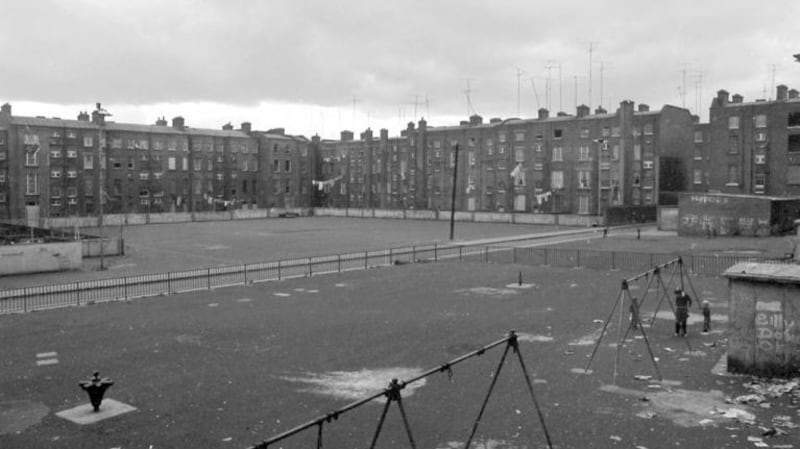
But the good memories far outweigh the bad. In the middle of the tenement buildings at the intersection of Gloucester Place and Seán McDermott Street sat a tarmac field of dreams and a hotbed for inner-city Dublin’s thriving street football scene.
In a city and a country where sport was militantly divided between football and the GAA, the Gloucester Diamond was one of the many places around the inner city where street football ruled. It was here that the likes of Frank O'Neill and Ben Hannigan honed the skills which would cement their places in the lists of League of Ireland greats.
It was also here that, with a short walk up Dorset Street and down Gardiner Street, a young Eamon Dunphy used to spend his time off from Manchester United playing in the famous Gloucester Diamond seven-a-side tournaments which filled the long summer evenings.
Dunphy spent three years as an apprentice under Matt Busby at United from 1962 to 1965 and it was during those summers, without Busby knowing, that he used to play on the hard tarmac of the Gloucester Diamond and Mountjoy Square.
"My biggest fear was that it'd get publicised because Manchester United would have gone mad," he says. "Billy Behan, who was their man in Dublin and a legendary figure, if he'd found out I would have been in deep trouble because I wasn't insured and it could have ended my career. My father and my brother used to go mental telling me I was putting everything on the line but I couldn't be stopped. My other fear was getting injured, if I'd got injured there my life was over."
But United never did find out and Dunphy never did get injured. So cherished are his memories of those times that he still has the little cup he was presented with when his team - known as The Hunters - managed to go all the way and win the Gloucester Diamond seven-a-side tournament, beating a much-fancied side, which included Frank O’Neill and Ben Hannigan, in the final.
For the seven-a-side tournament it wasn’t unusual for crowds in their thousands to gather around the Diamond, in the windows and on the roofs of the tenement buildings to watch the football while the turf depot, which was beside the pitch, was the place to go to hear any news from around the area.
“The day we played the final was a Sunday afternoon and I’ll never forget it, they were hanging out of the rafters from those big tenement buildings. Because they were in it and we were in it there was a huge crowd,” says Dunphy.
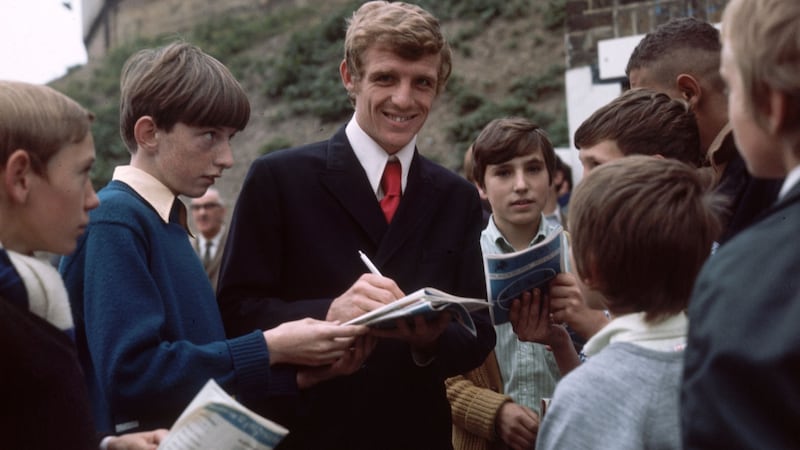
“They were the dream team and we weren’t. I was at United at the time and that was a big deal. It wasn’t really with my mates but it was a big deal around the place. It was taken very seriously, that tournament. The satisfaction was massive because you were playing with your friends. It went to show you don’t have to be playing at Wembley to feel like it.”
The Gloucester Diamond may have been a long way from the likes of Wembley or Old Trafford but for the residents of the area it was their focal point. The sounds of footballs being kicked, children playing and the gossip shared at the turf depot rang around the high walls.
“The spectacular thing about that was when it was all over the presenting of the medals and the trophies was something to see,” says Fagan. “They’d have a Ford flat back truck and they’d all be up on that presenting the trophies and the medals. It was magic, it was complete magic.
“I used to do the meals on wheels and I used to bring the food up to the elderly in those tenements because they weren’t able to come down those dark stairs and that’s when I started getting the recordings with them and recording the stories. Sometimes you’d go into them and you’d be knocking on the door but you wouldn’t get an answer so you’d push the door open and sure their heads were stuck out the back window watching the football.”
For Dunphy it was areas like the Gloucester Diamond and similar tarmac pitches around the city that created so many of the technically gifted footballers to come from Dublin in the 1960s, 70s and 80s. Around the world, the best players often come from the city and Dublin is no different in producing street footballers - players who might not be the biggest or the strongest but have creative, skilful streaks which Dunphy believes are honed by playing in tight spaces and on the tarmac. In his time it was the likes of John Giles and Liam Brady while more modern examples point towards Wes Hoolahan, who grew up on Killarney Street and, perhaps in years to come, Buckingham Street's Troy Parrott.
"People sometimes take the piss out of me because I talk about it so much but it really is where you learn the game. If you looked at Lionel Messi, say, or John Giles or Liam Brady, these really brilliant skilful players who all grew up playing football all day on the street. I watched the documentary a few weeks ago on Diego Maradona and where he came from was just a slum, there was nothing else - all you do is play football. Soccer is a game that originated in the streets, in the favelas, in the poor areas and until you learn the skills you learn in those places then you're not a natural. You can't really build a soccer player the way you build a golf swing or build a rugby player, it's different.
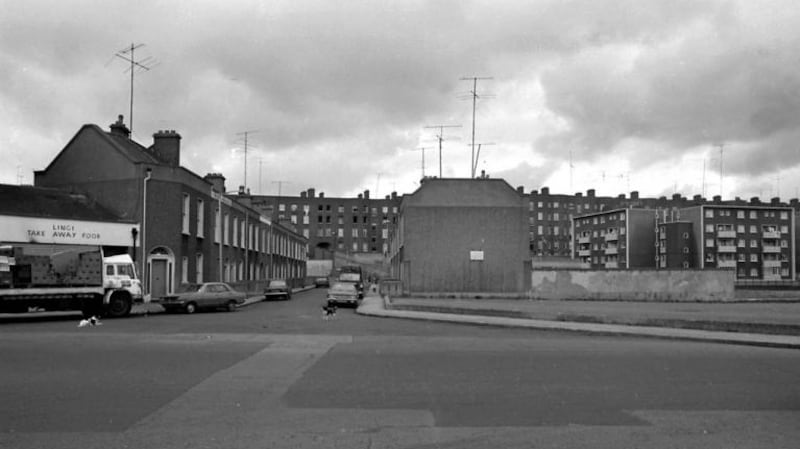
“I wasn’t strong enough or quick enough to be a top player but I had the skillset. I could dribble and pass and control - all the things you learn playing in a tight space. The Gloucester Diamond was a very tight space and the ball was very bouncy. You’d soon learn how to control it and your basic skillset was learned in a place like that - how to beat a man, how to nutmeg someone, how to avoid the big defender coming to get you. You can’t teach that, you learn that and it becomes instinctive.”
***
They stood back, and didn’t act
Those in power should have been sacked
Decimate the inner cities, move them out, bring in the wealthy – Ghosts of Overdoses by Damien Dempsey
***
“The streets now lie dark and ominous, tenement windows boarded and roofs gutted, cut open to the elements. They are now long corridors of silence awaiting the arrival of the executioner.”
So reads an article in The Irish Times on January 19th, 1981 as the Monto area was torn down and its residents moved out, the sounds of a football bouncing on the tarmac now replaced by those of heavy machinery. Three years previously, in August 1978, a controversial new development plan had been drawn up to demolish the tenement buildings while no guarantees of being rehoused in the area were provided for families.
The news came as a shock to the residents and, while many were delighted at the prospect of moving out of the dreadful tenement conditions, many more were left heartbroken to see the community divided.
“Some of them were delighted to get out but when they moved out there (to the suburbs) there was no community, it was closed hall doors,” says Fagan.
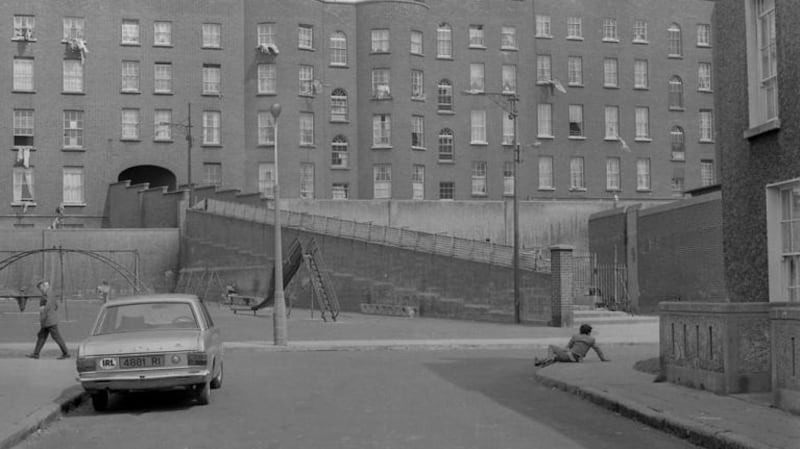
“In the inner-city you could come out and talk to somebody on the balcony or in the doorways but when you went out to the new housing estates with no infrastructure in place or anything people wanted then to get back into the inner city.”
The move also came at the time when heroin was just coming into the capital - a scourge that would flood through the streets and surrounding areas throughout the 1980s, in many cases destroying the new neighbourhoods which inner-city residents had moved to.
“They (the tenements) were appalling and when I say that I mean in many ways,” says Fagan. “They were refurbished in the late 30s and in the 70s and after that it went downhill. There were no jobs, the docks were gone and then you had the start of the drugs taking over.
"The whole area then kind of went downhill. People wanted to cleanse the area and the land became valuable. They worked through the whole lot and ended up then down at Sherriff Street with the IFSC and that there. So it was all kind of a masterplan which finished down at the docks then."
March 1982 did bring about some solace for the local residents when Independent TD Tony Gregory negotiated the Urban Development Areas Bill with Charles Haughey which led to a number of new houses being built in the city centre, including around the Gloucester Diamond, meaning some locals could be rehoused in the area.
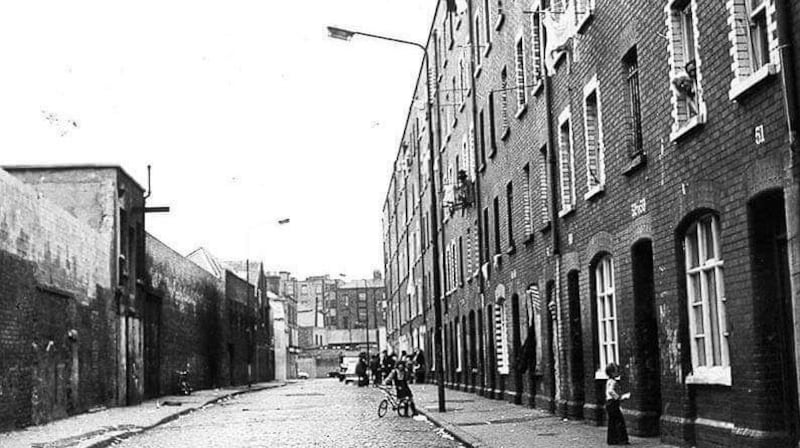
But in many ways the damage was already done. Hundreds of families had been moved and the huge crowds which used to turn out to watch the seven-a-side tournaments at the Diamond had become a thing of the past.
Walking around the area nowadays there is a strange mix of old flats, small houses and student accommodation while, just a few hundred yards further down towards the Liffey, it’s all suits, coffee cups and takeaway lunches around the IFSC.
But for Fagan and others who remember the 60s and 70s, it’s about keeping alive those memories.
Writing in The Irish Times in 1981, Frank Kilfeather said "in less than 12 months this area – for so long an independent Republic within a Republic – will be just a memory, a chunk of nostalgia. It is, in fact, the end of an era."
Through photographs and written word the memories live on and no more so than those of the Gloucester Diamond which, in an independent Republic within a Republic, may well have been the national stadium.













